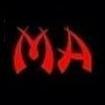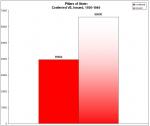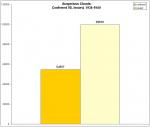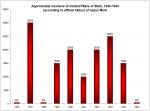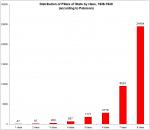-
Posts
22,214 -
Joined
-
Last visited
-
Days Won
68
Content Type
Profiles
Forums
Blogs
Gallery
Events
Store
Everything posted by JapanX
-
...within a matter of seconds we've got another BIG MYSTERY on our hands!!! :lol: And we've already have like a jillion unsolved mysteries... Shouldn't we call for Charlie Chan or Mr. Moto? We'll call this one "Mr.Moto and mystery Medal display" Rated R
-
Well... This will be your only comment Paul? Do you really think that rising suns in 1-5 classes are more numerous class than sacred treasures in 1-5? I excluded 6-8 because their comparative multiplicity couldn't be estimated (even roughly). If you have time, please answer to this question. Yesterday (right after you anathematized statistics ) you stated that clouds and pillars WERE equivalents of suns and clouds. Could you advise on what evidence you base this statement? And what will be yours explanation of reverse ratio for 1934-1945 period and especially for 1934-1940 period. Or do you think this is another bloddy lie? ;)
-
Yep, you are right about this one. I shouldn't make this statement in such incontestable manner. Especially when I don't have any hard proofs. Just rumors.
-
And another one. I believe that during peace time this inequality holds pretty well number of sacred treasures issued and conferred > number of rising suns issued and conferred What happend during war time is another thing. I agree with Paul. In times like these rising sun order became some sort of "not enough done - try harder" substitute for golden kite. From my experience rising suns were issued more often for combatants and sacred treasures for non-combatants (transport units, rare services, etc). And indeed for low classes (6,7 and 8) during war time such inequality could be right number of sacred treasures issued and conferred in lower classes < number of rising suns issued and conferred in lower classes But I believe for higher classes original inequality will still be right for war period. Maybe during war periods there was massive issues of rising suns in lower classes and that's why we observe such high numbers in documents on them. I think this is the only explanation. But the strangest thing with clouds and pillars is that pillars were dominated by clouds on every time period in every class. This is really strange. Cheers, Nick
-
Badge for the box 3.1 will cost you Miro But the good news - from time to time you could meet these unboxed rarities. Actually there are more owners of type 3 badges, than owners of type 3 boxes. Lucky you! Yep, guilty! Actually I think that your box have some chances to be type 2 box, because of turquoise-like color of interior on your second photo (type 3 boxes have pure white interior). If so - it's even more rare box - base from type 2 box and cover from type 3 box! Box for 4.1 will be easier to find I hope. Good luck with this task! Nick
-
Well, what we've got here is authentic box type 3.1 + authentic badge type 4 (it may be 4.1 or 4.2 - please check the central kanji on reverse ) + mysterious note, which is not a document. Cheers, Nick
-
This sentence sounds alarming
-
Ok. First thing - how you been? "Get a life and nice new piece" I guess Yep, it's a glue. Nice veteran display piece! Congrats! Identification please And merry Christmas my friend! Sincerely, Nick
-
Are you kidding me?! Of course! It will be great! One possibility is that that interior of box 4th type was inserted into box 3rd type. About document - no ideas at all. So please, if you can, show the badge, box interior and the document. Cheers, Nick
-
And another thing - I've never said that clouds are NOT exact equivalent of the Japanese Order of the Rising Sun and pillars are NOT exact equivalent of the Japanese order of Sacred Treasure. I said that from my point of view we have pretty strange ratio. The strong argument for equality clouds=suns is that my man Isoroko Yamamoto (山本五十六) was awarded by auspicious clouds and not by pillars of state. Yes, I think this one is pretty strong. Best regards, Nick P.S. Merry Christmas and Happy new year Paul (guess I forgot that I am not un ours mal léché ) Cheers!
-
Kinda strange to hear that from a banker The numbering is not continuous Paul, but thanks for advice. My subjective estimate. Maybe a little bit overoptimistic. Numbers on the documents? (sorry, but I think there was some tricky strange things with this numeration) But what about market prices? Don't you think that in phaleristics market price of the piece is a function of it's quantity (at least this is the main variable). Of course prices is not 1 to 3, but who's is talking about perfect market?! Ok. Maybe not 1:3, but I think suns are dominated by treasures - this is for sure. And even more truthful statement is that pillars are dominated by clouds. Anyone could pass this test - try to get yourself a sacred treasure in any class (excerpt 7-8) and than try to get a rising sun order. And one will know what I am talking about. We discussed this issue with Pieter not a long time ago and yes, it is well established fact that after the spring of 1940 nobody saw any official standard documents on golden kites - only notifications (these ones should be a temporal measure, but became a permanent one). Thank you for that revelation Paul! To sum up a) I am sure that pillars quantitatively dominates clouds b) I am sure that treasures quantitatively dominates suns The only question by how much in case of b) Although in case of b) - the proportion might changed in 1960s - after massive posthumous awarding were made. Nick
-
Hi Miro Merry christmas and happy new year! Thanks for this note. I believe what we've got here is box type 3.1 for badge 3rd type Regards, Nick
-
A little add-on about boxes for late type 4.1 and type 4.2 badges. After examining many different boxed type 4 specimens I think that it will be permissible for me to make the following statement. Sensho (for wounds in battle) badges usually came in balsa/cardboard boxes with gold kanji on the cover. Kosho (for wounds in public service) badges usually came in balsa/cardboard boxes with silver kanji on the cover.
-
A little Puzzle Well, there is one strange thing … Let me explain. According to Peterson Order of Auspicious Clouds was “… exact equivalent of the Japanese Order of the Rising Sun” (p. 142 of the 3rd edition) and Order of Pillars of State “…corresponds to the Japanese order of Sacred Treasure” (p. 147, 3rd edition). Usual ratio for conferred Suns/Treasures at least 1:3 (or even higher!). And the ratio for Clouds/Pillars 0,72:1 (for conferred orders during 1934-1940) and 1,05/1 (for minted orders during 1934-1945). Strange looking ratios! Well, this is not exactly what you expect from “exact equivalents”... Cheers, Nick
-
Striking differences! What we’ve got here is a clear cut case of overproduction or, this is more probable variant, planned finished goods inventory. With such high numbers of produced orders there is no room for Manchukuo Mint… And the variations we observe were created by same old Japan Mint.
-
Now it’s crystal clear, that there were no such things as “late-made-by-mythical-Manchukuo-Mint” pillars of states and auspicious clouds. They all came straight from Japan Mint! It will be very interesting to compare total number of issued clouds and pillars for 1934-1940 period with Peterson total numbers of conferred clouds and pillars for the same period. Next two charts will help us with this task.
-
136 500 for 1936-1945 period and 66 000 for 1936-1940 period.
-
Approximate numbers of pillars of state issued by Japan Mint by every year reader can find at the next chart.
-
Let’s take a look at this statistics in graphical form.


